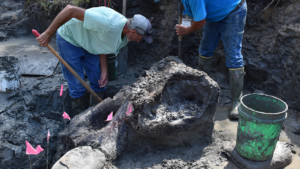
Exciting Discovery: New Dinosaur Species Similar to T. rex Unearthed in Asia
A remarkable revelation from the past has emerged as researchers have identified a new carnivorous dinosaur species that roamed the Earth approximately 165 million years ago. This discovery is not only significant for paleontology but also for understanding the Jurassic ecosystem.
Introducing Alpkarakush kyrgyzicus
The newly discovered dinosaur, named Alpkarakush kyrgyzicus, represents a unique genus and is the first theropod dinosaur identified in Kyrgyzstan. An expedition team comprising both German and Kyrgyz researchers made this groundbreaking find, as reported by the Bavarian State Natural History Collections in Germany. According to their press release, this discovery is one of the most important paleontological findings in Central Asia.
A Gap in the Jurassic Record
Prior to the identification of Alpkarakush kyrgyzicus, there was a notable absence of large Jurassic predatory dinosaurs in the region encompassing Kyrgyzstan, which lies between Central Europe and Eastern Asia. This discovery helps fill a critical gap in our understanding of Jurassic theropods and their geographical distribution.
Fossil Findings and Characteristics
The first fossils of Alpkarakush kyrgyzicus were initially uncovered in 2006 by Kyrgyz paleontologist Aizek Bakirov in a mountainous desert area near Tashkumyr. Over the years, further excavations yielded more fossils, including skull bones, pelvic vertebrae, and forearms. Researchers estimate that this dinosaur measured around 30 feet in length.
One of the most striking features of Alpkarakush kyrgyzicus is its prominent ‘eyebrow’ formed by the postorbital bone, located behind the eye socket, suggesting the presence of a horn. Additionally, unique characteristics can be observed on the dorsal vertebrae and femur, further distinguishing this species from other theropods.
Connections to T. rex
Alpkarakush kyrgyzicus shares its classification as a theropod with the iconic Tyrannosaurus rex (T. rex). While T. rex thrived during the later Cretaceous period and inhabited different regions, both dinosaurs exhibit similar physical traits, such as strong hind limbs and shorter forelimbs. Interestingly, modern birds are descendants of theropod dinosaurs, highlighting the evolutionary connection.
Insights from Leading Paleontologists
Professor Oliver Rauhut from the Bavarian Collection of Paleontology and Geology in Munich, who played a crucial role in the study published in the Zoological Journal of the Linnean Society, remarked, “This discovery closes a huge gap in our knowledge of Jurassic theropods. It leads us to important new insights into the evolution and biogeography of these animals.”
Parental Evidence and Cultural Significance
Alongside the adult specimen, researchers also discovered a smaller, juvenile Alpkarakush kyrgyzicus, suggesting a potential parent-child relationship. This finding adds another layer of intrigue to the study of these ancient creatures.
The name Alpkarakush pays homage to a mythological Kyrgyz bird known for assisting heroes in critical moments, linking the discovery to the rich cultural heritage of the Kyrgyz Republic.
Conclusion
The discovery of Alpkarakush kyrgyzicus not only enhances our understanding of Jurassic life but also emphasizes the importance of continued paleontological research in uncovering the mysteries of our planet’s history.

